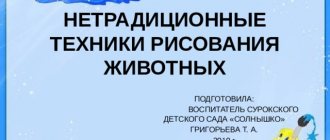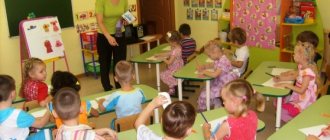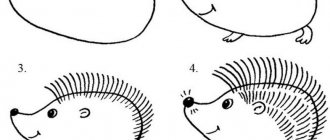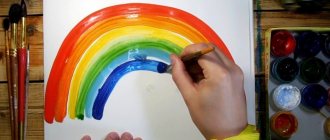GCD move
Parent:
Today we will go traveling. Tell me, what can you go on a trip with? From the proposed cards, choose any one that represents the type of transport.
Show it and name it.
Child (shows cards depicting transport by plane, train, car, bicycle, boat, etc.)
Parent:
That's right, well, we'll go on a trip in a hot air balloon. Close your eyes and imagine the blue sky and our hot air balloon. What is he like? Name the words that describe our balloon.
Child:
Large, beautiful, round in shape, has a basket for passengers, multi-colored, bright, light, etc.
Parent:
What's inside the balloon?
Child:
Well done! Let's fill the dome of our balloon with air. (The child performs breathing exercises). And getting into the basket is not so easy. You need to give your address. (The child says his address and goes into an imaginary balloon basket).
Parent
: Well, everything is ready for the trip. Let’s do a warm-up exercise before the long journey. The parent invites the child to listen to the poem:
The village is small, (clench your fists) My reliable village, (close your fingers in a “lock”) The village is dear, (fold your palms like a “house”) May you not be known to Rus', (clicks each of your fingers in turn) Although a little small, (hug yourself hands) But in my soul it is appropriate (spread your arms wide to the sides) Your beautiful face. (close palms one across the other)
Parent:
Well, now we’re going on a journey through the streets of our village, which is called what?
Parent: Our village is small but beautiful; there are many streets, interesting places and buildings. Each of us lives on our own street. Tell us about it: what is it called, what is it like, what is on your street? (child's story). Sample story:
The child answers (kindergarten, at home, etc.)
Parent
: What do all buildings have in common?
Child:
Every building has windows, doors, walls, and a roof.
Parent:
Tell me, how are these buildings different from each other?
Child:
The buildings differ from each other in height, wall color, decorations, etc.
Parent:
How else can buildings differ from each other?
Listen to all the child's options.
Parent:
Buildings may also differ from each other in the material from which they are built.
What is this house made of?
Child:
This house is built of brick.
Parent
: So what is he like?
Parent:
What is this house made of?
Child:
This house is built of stone. It's made of stone.
Parent:
What is a house built of wood?
Child:
A house made of wood is made of wood.
Parent:
Today you and I will draw the street of our village.
Parent:
Tell me, what is usually found on every street? (Buildings, houses).
Parent:
That's right, there are different houses on it. Tell me, how can you draw a house?
Listen to your child's options.
Parent:
Pay attention to the image of the central street of the village. What parts is the road divided into? (On the roadway and sidewalk).
Preview:
Summary of the plot lesson in the middle group
Teach children to create plot compositions, paint houses, flowers. Strengthen the ability to paint over objects, draw vertical and horizontal lines, and use non-traditional means of drawing pokes (when drawing flowers). Develop creativity and imagination. Cultivate a love of drawing.
Landscape sheet, gouache, brush, pedagogical sketches, illustrations depicting roads, flowers, houses.
A conversation about traffic rules, a didactic game “Road Traffic”, an outdoor game “Sparrows and Cars”. Viewing the houses of the village.
Educator. Listen to an excerpt from K.I. Chukovsky’s fairy tale “Aibolit”.
The hare came running and shouted:
- Ay, Ay! My bunny got hit by a tram!
My bunny, my boy
His legs were cut
And now he's sick and lame,
My little bunny!
Educator. Why do you think the bunny got hit by the tram? (children's answers). That's right, perhaps the bunny was playing with a ball on the street. Perhaps the bunny was crossing the road in front of a nearby vehicle. Or maybe he was crossing the street the wrong way. Guys, let's draw a street where there are no cars so that our bunny can play. The teacher invites the children to draw a street with houses on it and flowers blooming in the flower beds. Shows the stages of work.
-We will paint with paints. Where do we start our drawing?
— First you need to draw a house.
-The house is drawn in the middle of the sheet.
- That's right, and to draw a door we will draw two windows near the walls of the house, and in the middle a rectangle-door. This is what a beautiful house I got. Beautiful flowers were planted near the house, how can you draw them?
Preview:
Notes on drawing in the middle group “My Street”
Integration of educational areas: “Artistic and aesthetic development”, “Cognitive development”.
Preliminary work: field trip through the city streets, conversations about the city, reading fiction, drawing rectangular and square objects.
Equipment: Luntik toy, photographs of city streets, views of the sights of St. Petersburg, colored crayons, A4 sheets.
Children are located at work places.
The teacher brings in Luntik's toy.
Luntik: Hello. Where did I end up? And who are you? (children's answers)
Luntik: I am Luntik. I fell from the moon. Where did I end up?
Educator: Hello, Luntik. We'll tell you everything.
Guys, what is the name of our city?
What street is our garden on?
Luntik: What an interesting name. Is your street beautiful? Tell us about her? (children's stories)
Educator: Well done children. Look Luntik, we have photographs of our city, let's take a look and find familiar places. (I post the photo on the board).
Let's go Luntik with the guys for a walk along our street.
Relaxation exercise “Walk”.
— Walking along a narrow path.
- Walking on toes.
- Walking on your heels.
- Let's swing on a swing.
Luntik: It was a good walk. You have a big, beautiful street, and how many houses... Why does a person need a house? (children's answers).
Educator: Smart girls. Guys, we all have houses where you live with your beloved family. Who remembers their home address? (children's answers)
Luntik: Why do people need an address? (children's answers)
Luntik: I would like to visit the children.
Educator: I think, Luntik, the guys will be very glad to see you as a guest. In the meantime, play with us.
Finger game “Building a house”
I knock with a hammer, I knock
I'll hammer a hundred nails,
We will build a house, a house,
We will live together in it.
Luntik: Guys, they told us on the moon that you have a lot of animals and birds on your planet. Which animal has which house?
Half of the children are given cards with pictures of animals and birds, and the other half are given houses. Everyone needs to find a mate.
Educator: Well done guys, played well.
Listen to B. Serikbaev’s poem “Home”
I will draw a multi-story house. Of course, it will be a little papery. Of course, it will not be very brick, but it will be white-walled, but it will be nice. Surely no one will ever drive a puppy away from this house.
Educator: Guys, do you want to invite Luntik to visit you? Then I suggest you draw your street and your house so that it is easy for Luntik to find where you live.
Children draw their idea of the picture with wax crayons.
They draw a street, tall buildings, various types of transport. The teacher provides assistance if necessary.
Educator: Children, today we talked about our city, about the street on which our garden is located. You drew good drawings. Which of you would like to tell us in more detail about your drawing? Luntik, did you like playing with us?
Luntik: Guys, I’m so glad I came to you. I learned so many interesting things. What wonderful drawings you drew. I will definitely now find your house and come to visit you. You guys are great.
Educator: Did you guys like it? What was interesting? What new have you learned? Let's say goodbye to our guest, it's time for him to return to the moon.
Source








